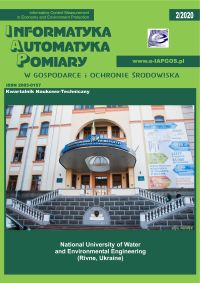EXERGY-BASED CONTROL STRATEGY IN A DWELLING VENTILATION SYSTEM WITH HEAT RECOVERY
Article Sidebar
Open full text
Issue Vol. 10 No. 2 (2020)
-
TRANSISTOR-BASED TEMPERATURE MEASURING DEVICE
Oleksandra Hotra4-7
-
ANALYSIS OF ALL-PASS FILTERS APPLICATION TO ELIMINATE NEGATIVE EFFECTS OF LOUDNESS WAR TREND
Marcin Maciejewski, Wojciech Surtel, Krzysztof Nowak8-11
-
LOGICAL CLASSIFICATION TREES IN RECOGNITION PROBLEMS
Igor Povhan12-15
-
RANKING OF WEBSITES CREATED WITH THE USE OF ISOWQ RANK ALGORITHM
Mariusz Duka16-19
-
OVERVIEW OF BROADBAND INFORMATION SYSTEMS ARCHITECTURE FOR CRISIS MANAGEMENT
Jacek Wilk-Jakubowski20-23
-
TIME-VARIANT MODEL OF HEAT-AND-MASS EXCHANGE FOR STEAM HUMIDIFIER
Igor Golinko, Volodymyr Drevetskiy24-27
-
NONSTATIONARY HEAT CONDUCTION IN MULTILAYER GLAZING SUBJECTED TO DISTRIBUTED HEAT SOURCES
Natalia Smetankina, Oleksii Postnyi28-31
-
REAL-TIME MONITORING OF CELL CULTURES WITH NICKEL COMB CAPACITORS
Andrzej Kociubiński, Dawid Zarzeczny, Maciej Szypulski, Aleksandra Wilczyńska, Dominika Pigoń, Teresa Małecka-Massalska, Monika Prendecka32-35
-
AN OVERVIEW OF CLASSIFICATION METHODS FROM DERMOSCOPY IMAGES IN SKIN LESION DIAGNOSTIC
Magdalena Michalska, Oksana Boyko36-39
-
SOFTWARE DEVELOPMENT FOR SMART HOME PROCESS CONTROL
Vitalii Kopeliuk, Vira Voronytska, Volodymyr Havryliuk40-43
-
EXERGY-BASED CONTROL STRATEGY IN A DWELLING VENTILATION SYSTEM WITH HEAT RECOVERY
Volodymyr Voloshchuk, Mariya Polishchuk44-47
-
ANALYSIS OF THE ELECTRICITY METERING SYSTEM FOR OWN ELECTRIC SUBSTATION NEEDS
Sergiy Stets, Andriy Stets48-51
-
RESEARCH ON THE COMBUSTION PROCESS USING TIME SERIES
Żaklin Grądz52-55
-
RESEARCH AND SIMULATION OF THE LOCAL NAVIGATION SYSTEM OF TERRESTRIAL MOBILE ROBOT
Andrii Rudyk, Viktoriia Rudyk, Mykhailo Matei56-61
-
DESIGN OF MULTIFUNCTION SIMULATOR FOR ENGINE ROOM PERSONNEL TRAINING
Artem Ivanov, Igor Kolosov, Vadim Danyk, Sergey Voronenko, Yurii Lebedenko, Hanna Rudakova62-69
-
MODEL PREDICTIVE CONTROL APPLICATION IN THE ENERGY SAVING TECHNOLOGY OF BASIC OXYGEN FURNACE
Oleksandr Stepanets, Yurii Mariiash70-74
Archives
-
Vol. 12 No. 4
2022-12-30 16
-
Vol. 12 No. 3
2022-09-30 15
-
Vol. 12 No. 2
2022-06-30 16
-
Vol. 12 No. 1
2022-03-31 9
-
Vol. 11 No. 4
2021-12-20 15
-
Vol. 11 No. 3
2021-09-30 10
-
Vol. 11 No. 2
2021-06-30 11
-
Vol. 11 No. 1
2021-03-31 14
-
Vol. 10 No. 4
2020-12-20 16
-
Vol. 10 No. 3
2020-09-30 22
-
Vol. 10 No. 2
2020-06-30 16
-
Vol. 10 No. 1
2020-03-30 19
-
Vol. 9 No. 4
2019-12-16 20
-
Vol. 9 No. 3
2019-09-26 20
-
Vol. 9 No. 2
2019-06-21 16
-
Vol. 9 No. 1
2019-03-03 13
-
Vol. 8 No. 4
2018-12-16 16
-
Vol. 8 No. 3
2018-09-25 16
-
Vol. 8 No. 2
2018-05-30 18
-
Vol. 8 No. 1
2018-02-28 18
Main Article Content
DOI
Authors
Abstract
The paper presents energy and exergy analysis of a typical dwelling ventilation system with heat recovery for Ukrainian climatic conditions using a quasi-steady state approach over 24-hour time-steps. Evaluation of such systems on the base of the first law of thermodynamics demonstrates that heat recovery is beneficial for the whole variety of operational modes. Such methodology identifies as a thermodynamic inefficiency only energy losses to the surroundings with the exhaust air. The exergy-based analysis can detect additional inefficiencies due to irreversibilities within the components of the system. As a result the exergetic investigations show that for the ventilation systems there are operating conditions for which heat recovery increases exergy of fuel expended to provide the ventilation air compared to cases without bringing any recovery of heat and additional power consumption to drive the air flow by the fans. For the specified system, in case of switching ventilation unit to the operation mode of lower values of spent fuel exergy it is possible to provide annual saving of the primary energy sources from 5 to 15%.
Keywords:
References
Gjennestad M.Aa., Aursand E., Magnanelli E., Pharoah J.: Performance analysis of heat and energy recovery ventilators using exergy analysis and nonequilibrium thermodynamics. Energy and Buildings 170, 2018, 195–205. DOI: https://doi.org/10.1016/j.enbuild.2018.04.013
Hepbasli A.: Low exergy (LowEx) heating and cooling systems for sustainable buildings and societies. Renewable and Sustainable Energy Reviews 16(1), 2012, 73–104. DOI: https://doi.org/10.1016/j.rser.2011.07.138
Jensen J.K., Ommen T., Reinholdt L., Markussen W.B., Elmegaard B.: Heat pump COP, part 2: Generalized COP estimation of heat pump processes. Proceedings of the 13th IIR-Gustav Lorentzen Conference on Natural Refrigerants 2, 2018, 1136–1145.
Laverge J., Janssens A.: Heat recovery ventilation operation traded off against natural and simple exhaust ventilation in Europe by primary energy factor, carbon dioxide emission, household consumer price and exergy. Energy and Buildings 50, 2012, 315–323. DOI: https://doi.org/10.1016/j.enbuild.2012.04.005
Mert Cuce P., Riffat S.: A comprehensive review of heat recovery systems for building applications. Renewable and Sustainable Energy Reviews 47, 2015, 665–682. DOI: https://doi.org/10.1016/j.rser.2015.03.087
Rosen M.A., Dincer I.: Effect of varying dead-state properties on energy and exergy analyses of thermal systems. International Journal of Thermal Sciences 43, 2004, 121–133. DOI: https://doi.org/10.1016/j.ijthermalsci.2003.05.004
Sakulpipatsin P., Boelman E., Cauberg J.J.M.: Exergy analysis as an assessment tool of heat recovery of dwelling ventilation systems. Int. J. of Ventilation 6(1), 2007, 77–85. DOI: https://doi.org/10.1080/14733315.2007.11683767
Tsatsaronis G.: Definitions and nomenclature in exergy analysis and exergoeconomics. Energy 32, 2007, 249–253. DOI: https://doi.org/10.1016/j.energy.2006.07.002
Zmeureanu R., Wu X.Y.: Energy and exergy performance of residential heating systems with separate mechanical ventilation, Energy 32(3), 2007, 187–195. DOI: https://doi.org/10.1016/j.energy.2006.04.007
National Standard of Ukraine: Instruction for development of energy passport of buildings under new construction and reconstruction: DSTU-N B A.2.2-5:2007. Minregionbud of Ukraine, Kiev 2008.
Article Details
Abstract views: 420
License

This work is licensed under a Creative Commons Attribution-ShareAlike 4.0 International License.






